Houseplants. They are the perfect splash of color in those home magazine spreads and each leaf is always at its best on Instagram. But do you know how to keep them alive in your own home? Are you ready for plant parenthood? Can you keep that gorgeous Fiddle Leaf Fig thriving in your living room? The answer is HECK YES, with the right care and conditions! But it takes a little time, research and practice.
Indoor plants can be challenging at first.
The home environment is very different than outside on the patio or in the garden bed. Less light, humidity, and only the nutrients and water you provide in a little pot, not to mention kids and pets knocking them over.
A microcosm of life at your fingertips. Houseplants and soil are alive after all, and once you figure out how to hone these plant parent skills, they will reward you with magical little baby leaves.

Plant care can also be self care
My weekly plant duties are a time for noticing new growth, checking health, and caring for each plant. After the kids are asleep, when the house is quiet, I turn on my audiobook, pour some tea *ahem* wine, and grab the watering can, snips, and cloth and tend to my jungle.
I have around 100 plants including propagations inside my average size house and many more in containers outside, so fair warning: it can be addicting!
I am a mom of a sweet, adorable two-year-old boy, a wild and emotional six-year-old boy, a nine-year-old terrier mix, and a challenging 60 lb. six-month-old Great Pyrenees mix (who likes to knock over plants and dig in planters). Add a husband and 100 houseplants to the bunch and it is safe to say my nurturing need is fulfilled.
I am tired and stressed out and need a serious break, but something about those plants, they relax me.
Seeing that new baby Monstera leaf unfurl brings me joy. It tells me I am good at what I am doing; rewarding me for my efforts while daring me to keep it happy. So when I have no space for a new plant and cringe at the idea of figuring out how to keep them all alive while I vacation, the more the merrier! I can’t be the only one whose plant collection grew being home in 2020.
I had to begin plant parenthood somewhere.
I used to kill succulents like no tomorrow. I think once you find a plant you can be successful at taking care of, it will add to your life and confidence. Be proud of your little vine growing in the corner! Plus, they are the best decor.
So next time you are at that the store, mosey on over to the plant section and see if anything sparks joy for you. Or better yet, head to a local nursery and ask questions! I would suggest starting with an easy-going plant, because they will forgive you for overwatering (we all do in the beginning) or forgetting them for way too long (you will).
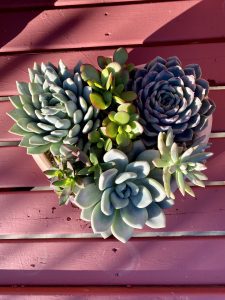
Here are 4 things to know about plant parenthood:
Choose
Great starter plants include Spider plants, Snake plants, Pothos, Aloe, ZZ Plant, and Succulents.
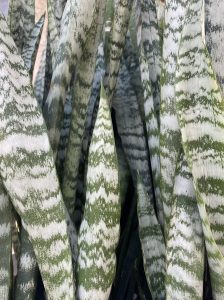
Try one of these gateway plants before you pick the beautiful Calathea with exotic leaves. Once you find the beginner plant of your dreams, read the tag or look it up on your phone.
Read the care instructions and decide if it fits your lifestyle.
There are plants for everyone (unless maybe you’re not home for long periods…go faux)! You don’t want to be overwhelmed with the care requirements. A plant that likes to dry out between watering is perfect. Also, if you have children or pets, make sure it’s not poisonous or can be kept out of reach.
TIP: Before purchase, inspect the chosen one for pests, which hide under the leaves.
Light
Light is so important for houseplants. Find a spot in your home with (depending on its needs) bright indirect light and not near an air/heater vent or drafty door. If it is not getting enough light it will become leggy and reach for the light (you will see this a ton with succulents). If the plant gets too much direct sunlight, the leaves may burn.
Indirect bright light is great for most houseplants, so near a north or east facing window. This kind of light is bright enough to cast a shadow and to read by. If you have south or west facing windows, sometimes a sheer curtain can help diffuse the direct light or placing the plant a few feet back from the window. Feel free to test spots out and move the plant if it doesn’t thrive there. Some of the pickier plants out there will drop leaves if you move them from where they like it. Fiddle Leaf Fig, I’m lookin at you!
TIP: Rotate your pot a little every watering and it will grow evenly and more full.
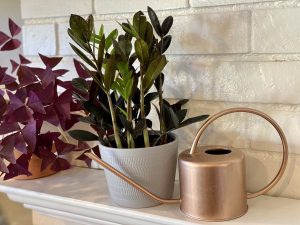
Watering
Improper watering is the number one killer of houseplants. Remember that overwatering is worse than under-watering!! When in doubt, don’t water. Not many houseplants need watered everyday.
Please leave your new plant in the plastic grow pot it comes in. Do not repot right away, to avoid shocking the plant and let them acclimate. Remember it came from a nursery with ideal growing conditions. You can put a grow pot into a decorative cover pot, or cache pot, to look cuter. The holes will help you so much as they let all that extra water out.
An overwatered plant will slowly rot or get disease (or those annoying Fungus Gnats) whereas a thirsty plant will tell you it needs a drink (maybe by drooping, curling leaves, wrinkled leaves, or the dreaded brown crunchy leaves) and will most likely bounce right back after a deep watering.
Always remove the dead leaves.
So how do you know how to water a houseplant properly? Let’s determine how wet your soil is. Stick your finger into the soil about two inches down and feel your finger. Is it moist? If it is, then do not water. If it comes out dry, poke a few more spots and if the finger has no soil stuck to it, time for a water. Water evenly and thoroughly.
Also note how much lighter your plant pot is when it needs water versus when it’s been watered. Eventually you will know it is dry by lifting the pot. I recommend a moisture meter for new plant parents because it helps you learn how to trust your finger. They are $10 online or at a nursery.
You stick it into the soil a few inches and it will tell you the moisture level. If it is over 4, (moist) you are good. If it is in the red, go ahead and water. Don’t be intimidated as they are easy once you learn to read them.
If your soil is super dry, it will look and feel it. The soil may be pulling away from the sides of the pot or the water may not even absorb. If this happens, just take a pencil or something similar and poke some holes. Break up that dry soil (gently to avoid breaking roots) so it has a better chance of absorbing the water and water it thoroughly.
You can even leave the pot in a bowl of water so it can suck the water up through the holes at the bottom for around 15 minutes or more, which is called bottom watering.
TIP: Always water enough so that it drips out the bottom of the pot.
Fertilizer and Soil
Feeding your plant is eventually important too. You can fertilize during active growing season. You can look up the type of plant to see the fertilizing needs. FYI if you don’t ever fertilize, the plant will probably look fine for a long time before it runs out of nutrients or needs repotted.
When you buy a plant, it most likely has slow release fertilizer in the soil. Again, just look up your plants needs. Over time, when the plant fills the pot and it becomes root bound (roots start growing out the bottom holes), it is time to repot and add new good quality potting soil. Adding perlite always helps drainage.
Only go up one size pot when you repot. Why? If the plant is too small for the pot, soil can stay wet longer and lead to root rot.
Also know that a terracotta or a porous pot will help wick moisture out of the soil. This is great for cacti and plants that like drying out. It is good practice to check the whole plant every month for pests as they can come out of nowhere, spread fast, and hurt your plants.
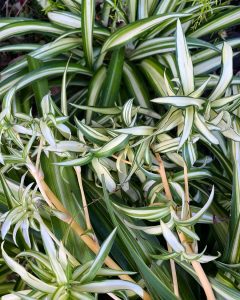
TIP: Too much dust on a leaf can affect photosynthesis so give a gentle wipe down on both sides when they look dusty.
Now that you know the recipe for houseplant success and are ready for plant parenthood, go enjoy that new plant and bring nature indoors this Spring.
Remember, if at first you don’t succeed, buy another!
Plants can be brought back to life if you do some research but you are bound to lose a few; don’t get discouraged. Just wait until you learn about propagating a cutting (producing a new plant from the parent plant). You can and will turn that thumb greener and you may end up loving plants as much as I do.
So, for the love of houseplants and plant parenthood, get out there and find a plant you love! Check out my plant journey on Instagram and please reach out with any questions or comments!






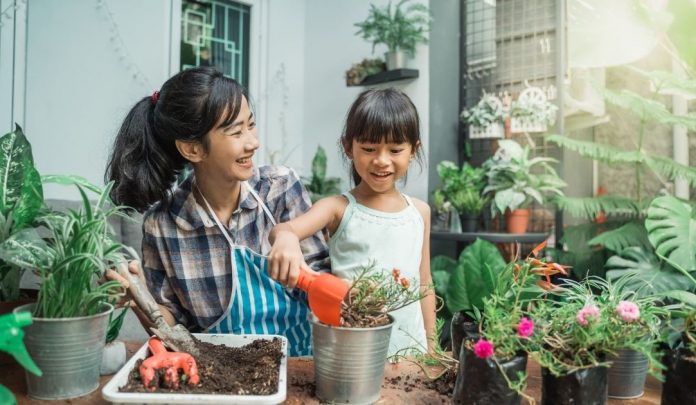








This article was very informative, thank you!!!
Glad you enjoyed! Happy planting!
Wow great starter guide for those curious about becoming a first time planter parent. Thank you for sharing this beginners guide and a little about yourself and family.
Thanks for the love! I hope you have a great Spring!
I learned so much! I’m going to go get a few plants now. Thanks for the inspiration.
I learned so much! I’m going to go get a few plants now. Thanks for the inspiration.
Comments are closed.